|
Important Articles on
Iodine Supplementation
 The Great Iodine Debate --
The Great Iodine Debate --
 (Weston A. Price Foundation) (Weston A. Price Foundation)
 Iodine & Your Thyroid
Iodine & Your Thyroid
 Preventing and treating
Preventing and treating
 diseases with iodine diseases with iodine
 The Need for Iodine
The Need for Iodine
 Supplementation Supplementation
 Lugol�s solution and other
Lugol�s solution and other
 iodide preparations: perspec- iodide preparations: perspec-
 tives and research direc- tives and research direc-
 tions in Graves� disease tions in Graves� disease
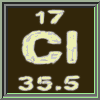 Cancer & Chlorine:
Cancer & Chlorine:
It Does More
Than Just
Displace Iodine

 "We are quite convinced, based on our
study, that there is an association between
cancer and chlorinated water."
"We are quite convinced, based on our
study, that there is an association between
cancer and chlorinated water."
 Medical College of Medical College of
Wisconsin Research
Team
 "Cancer risk among people drinking chlorinated water is
93% higher than among those whose water does not contain chlorine."
"Cancer risk among people drinking chlorinated water is
93% higher than among those whose water does not contain chlorine."
 U.S. Council Of U.S. Council Of
Environmental Quality
 "Putting chlorine in the water supplies is like starting a time bomb. Cancer, heart trouble, premature senility; both mental and physical, are conditions attributable to chlorine treated water supplies. It is making us grow old before our time by producing symptoms of aging, such as hardening of the arteries."
"Putting chlorine in the water supplies is like starting a time bomb. Cancer, heart trouble, premature senility; both mental and physical, are conditions attributable to chlorine treated water supplies. It is making us grow old before our time by producing symptoms of aging, such as hardening of the arteries."
 Dr. Herbert Schwarts Dr. Herbert Schwarts
Biological Chemist
 "Nothing can negate the incontrovertible fact, the basic cause of
atherosclerosis and resulting entities such as heart attacks and
stroke, is chlorine."
"Nothing can negate the incontrovertible fact, the basic cause of
atherosclerosis and resulting entities such as heart attacks and
stroke, is chlorine."
 Joseph Price, M.D. Joseph Price, M.D.
Coronaries, Cholesterol
Chlorine
 "I deal extensively on several newsgroups that focus
on animal cancers - particularly feline leukemia,
mast cell tumors, etc. I am amazed by the upsurge
in these kind of cases and the only common element
I can find in all of it is water. That's right.
I have 28 cats of my own and they all drink
from a pond - none of them have ever developed
any kind of cancer, nor have those of my friends
who are committed to avoiding chlorinated water.
The correlation is too widespread to ignore
out of hand."
"I deal extensively on several newsgroups that focus
on animal cancers - particularly feline leukemia,
mast cell tumors, etc. I am amazed by the upsurge
in these kind of cases and the only common element
I can find in all of it is water. That's right.
I have 28 cats of my own and they all drink
from a pond - none of them have ever developed
any kind of cancer, nor have those of my friends
who are committed to avoiding chlorinated water.
The correlation is too widespread to ignore
out of hand."
 "Jim" "Jim"
sunwatt@starband.net
in corresondence
with AO's Jim Carr
May 13, 2002
 There is a lot of
good material supporting in the public domain supporting
abstinence from chlorinated water - and even using pools
and spas that use halogens (i.e. chlorine and bromine)
to clean the water. (This is, in fact, the reason we
created H3O for Spas & Pools.)
One of the best sources is
WaterWarning.com,
and there are plenty more on our
H3O Spa page itself.
 If you have any questions
about the importance of avoiding chlorine, you owe it to yourself
to do a little research ...
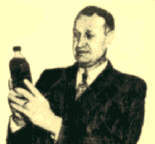
The Harry
Hoxsey Connection
 Though we deal
with the chronicles of 20th century cancer
specialist and naturopath, Harry Hoxsey, N.D.,
on
a separate page - no mention is made, in the book,
movie, or subsequent web pages that have been devoted
to him, of the real active ingredient in his internal
tonic. An unassuming, forthright man, he didn't
attempt to hide his formulas. In his signature work,
You Don't Have To Die (1956), he reveals the
ingredients in his internal product: potassium iodine,
a potent antimicrobial and an ingredient in Lugol's.
The other ingredients are all herbs, some of which, like
Essiac Tea, are only mildly cancerolytic.
How Much Iodine
In a Drop . . . ?
 Lugol's is now
made in different strengths -- differing from the original
formulation (see A History of Lugol's). Lugol's is now
made in different strengths -- differing from the original
formulation (see A History of Lugol's).
 Using our formula
(see sidebar at far right), you use the following calculation. Since the density of
Lugol's is close to that of water, you can use the traditional
equivalency of one "metric" drop = .05mL, or 20 drops per milliliter --
note that a metric drop differs from a medical drop (1/12 mL) or
an Imperial drop. One ml. contains 2.913% iodine and iodine compound (potassium
iodine -- you divide 4,120 ml. by 120 ml to get 2.913%). Using our formula
(see sidebar at far right), you use the following calculation. Since the density of
Lugol's is close to that of water, you can use the traditional
equivalency of one "metric" drop = .05mL, or 20 drops per milliliter --
note that a metric drop differs from a medical drop (1/12 mL) or
an Imperial drop. One ml. contains 2.913% iodine and iodine compound (potassium
iodine -- you divide 4,120 ml. by 120 ml to get 2.913%).
 Each bottle, therefore,
contains about 47.3 teaspoons. (Divide 236.52 ml. in one 8 fl. oz.
bottle by 47.3, as a check sum exercise, and you get 5 ml. per
teaspoon.) Using the formula we provide on the right panel,
4,120 ml. (4 liters) contains roughly 120 grams of iodine.
One 8 fl. oz. container contains 6.89 grams (6,890 mg.).
Divide by 47.3 and you get 145.63 mg. Each bottle, therefore,
contains about 47.3 teaspoons. (Divide 236.52 ml. in one 8 fl. oz.
bottle by 47.3, as a check sum exercise, and you get 5 ml. per
teaspoon.) Using the formula we provide on the right panel,
4,120 ml. (4 liters) contains roughly 120 grams of iodine.
One 8 fl. oz. container contains 6.89 grams (6,890 mg.).
Divide by 47.3 and you get 145.63 mg.
 Thus, 2/3 of one
teaspoon yields roughly 100 mg. of iodine. Thus, 2/3 of one
teaspoon yields roughly 100 mg. of iodine.
 The U.S. RDA for iodine is
80 to 150 �g; the European RDA is 150 �g). Thus,
one teaspoon of Lugol's is roughly 1,000 times this amount ! The U.S. RDA for iodine is
80 to 150 �g; the European RDA is 150 �g). Thus,
one teaspoon of Lugol's is roughly 1,000 times this amount !
 If you are not using high
therapeutic dosages and simply want a supplemental level, one
metric drop per day (see "drop table" at
right for alternative definitions) or roughly 1.45 mg. or
1,450 �g) is usually sufficient. If you are not using high
therapeutic dosages and simply want a supplemental level, one
metric drop per day (see "drop table" at
right for alternative definitions) or roughly 1.45 mg. or
1,450 �g) is usually sufficient.
 The drop dispenser
sold by Alpha Omega Labs for $1.25 is a pharmaceutical-grade, plastic
"metric drop" dropper. However, if you know your the dispensing volume
of a clean dropper you already have -- (see chart at right) --
that will work, too.
|
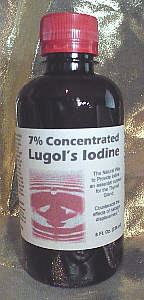
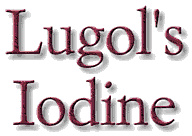
Code #564 (2.2%) -- 8 Fl. Oz. -- $18.95
Code #565 (3%) -- 8 Fl. Oz. --- $18.95
Code #566 (7%) -- 8 Fl. Oz. -- $29.95
Code #567 (7%) -- 1 Fl. Oz. --- $11.75
Code #568 (15%) -- 1 Fl. Oz. -- $18.25
Code #569 -- Dropper -- $1.25
(Pharma-plastic, "metric drop" dropper)
Supplemental serving size:
1 drop (1.45 mg. iodine if using #565),
( serving size / dosage).
Formulas We Use
 Order
Order
How we've managed to weaken one of the body's
primary mechanisms of defense and how it can be restored
with iodine supplementation --- easily and cheaply
 he
role of iodine
in human nutrition is
well-established - as are its deficiency diseases and the conditions to
which its deficiency can contribute (i.e.
goiter,
cretinism,
hypothyroidism, etc.)
 The amount of iodine necessary
to void diagnosable deficiency is quite small. Below, for example, we provide
the U.S. Recommended Daily Allowance for iodine in mcg.'s.
| Infants | 40�50 |
| Ages 1�3 | 70 |
| Ages 4�6 | 90 |
| Ages 7�10 | 120 |
| Age 11 older | 150 |
| Pregnant women | 175 |
| Lactating women | 200 |
 Optimally, people would get
all their iodine from dietary sources: kelp, seaweed, certain
types of ocean fish, and vegetables grown in iodine-rich soil --
while watching their intake of iodine-inhibiting foods and drugs
(see goitrogen).
But many ocean-bearing iodine-rich foods are now unavailable,
and agricultural farmland is increasingly
iodine-deficient, leading to reduced levels of iodine in
foods. Other areas, such as the Great Lakes region in the U.S.,
are naturally deficient in iodine -- a fact that lead to the
massive goiter in the 1930's, when 40% of the people living
in Michigan suffered from goiter.
 In 1924, iodine was first
added to table salt as a preventative measure, and by 1940,
the practice was in general consumer use. Using iodized salt
has, no doubt, been effective: it contains about 76 mcg.
of iodine per gram. The average person consumes at least
3 grams of iodized salt daily, exceeding the RDA for iodine
by 150 mcg. However, iodized salt has many other drawbacks:
it contains aluminum and processing chemical residues,
its overuse creates the well-documented conditions associates
with high sodium intake and sodium-potassium imbalance, etc.
 With treated salt's convenient
little addition to the Western diet - its integration accelerated
by the explosive expansion of fast food outlets, at which
table salt's cup doth overflow, one might think we have
seen the last of iodine deficiency.
 Hardly.
 Enter "halogen
displacement" and the effects of chlorine intake on
the body's small reserve of iodine. Table salt, by definition,
is mostly
"sodium chloride" (what chemists call a "halide" - or a halogen
tied to a mineral, making it a "salt" of a halogen). Although
bound to sodium, the use of table salt as a delivery vehicle
for iodine ironically presents a situation where you ingest far
more chlorine, which displaces iodine (as we will see in a moment)
than you do the iodine itself.
 You see, chlorine, which has
been used extensively since 1904 to control microbes
in public drinking water, belongs to the same class
of elements as iodine: the "halogens" - or elements
that are one step removed from the "inert elements" (or gases)
because they have just one electron missing from their
outer shell to make it inert (non-reactive).
This makes them quite readily reactive.
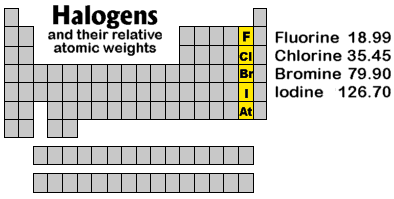
 The mechanism behind
"halogen displacement" was probably best described by J.C. Jarvis, M.D.
( Folk Medicine, Henry Holt & Co., 1958, HB, p. 136),
who wrote: "The clinical activity of any one of these four
halogens is in inverse proportion to its atomic weight.
This means that any one of the four can displace the element
with a higher atomic weight, but cannot displace an element with
a lower atomic weight. For example, flourine can displace chlorine,
bromine and iodine because flourine has a lower atomic weight
than the other three. Similarly, chlorine can displace bromine
and iodine because they both have a higher atomic weight.
Likewise, bromine can displace iodine from the body because
iodine has a higher atomic weight. But a reverse order
is not possible. A knowledge of this well-known chemical
law brings us to a consideration of the addition of
chlorine to our drinking water as a purifying agent.
We secure a drinking water that is harmful to the body
not because of its harmful germ content but because
the chlorine content now causes the body to lose the
much-needed iodine..."
 To counter the effects
of iodine loss, Dr. Jarvis recommended various methods
including: (1) Eating foods
rich in iodine: food from the ocean, radishes,
asparagus, carrots, tomatoes, spinach, rhubarb, potatoes,
peas, strawberries, mushrooms, lettuce, bananas,
cabbage, egg yolk, and onions; (2) Painting a small
area of the body with tincture of iodine; and (3) taking
preparations known to be rich in iodine, including
cod liver oil, kelp tablets ...
 But he was particularly
keen on the power of Lugol's iodine, for treating
various illnesses, including colds and flu, and for
countering the effects of stress: "Supposing you do
follow the suggestions outlined above and find that
some weeks the pressures of your private and your business
life are causing you to lose the ability to bounce back.
Then you should add a drop of Lugol's solution
of iodine to your glass of apple or grape juice at
breakfast, or you may take it in the mixture of apple
cider vinegar and water. The point is that the
potassium in the solution blocks off the body mechanism that organizes
for aggressive action, releasing its hold on the body
when opportunity for rest and relaxation arises.
The iodine swings into action the body and the building
up and storing of body reserves. When working under
pressure, include the Lugol's solution dose
each day until the period of pressure passes.
If it should happen that your body becomes saturated
with iodine, you will find that there is an increase
of moisture in the nose. If this occurs, omit the
iodine until the nose is normal."
 Read directions thoroughly
before use.
Label Information
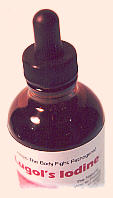
 The following information is
taken directly from our Lugol's label. Please keep in mind
that your dosage is dependent on whether you are using Lugol's
as a supplement, or for therapeutic purposes and/or at the advice
of a medical practitioner: The following information is
taken directly from our Lugol's label. Please keep in mind
that your dosage is dependent on whether you are using Lugol's
as a supplement, or for therapeutic purposes and/or at the advice
of a medical practitioner:
 Supplemental Dosage (2.2%): One drop (roughly 1.45 mg: see panel
at left for calculation).
Supplemental Dosage (2.2%): One drop (roughly 1.45 mg: see panel
at left for calculation).
 Directions: Take one drop per daily for general health.
In times of bacterial or viral
infection, take one-half tsp. (about 72 mg.) three times per week (i.e Monday, Wednesday, Friday),
or as recommended by your health care practitioner.
Take Lugol�s on an empty stomach about 20 minutes before eating in an 8 oz.
(236 ml.) glass of distilled or purified water with one teaspoonful of
apple cider vinegar added for slight acidification. Also see:
Directions: Take one drop per daily for general health.
In times of bacterial or viral
infection, take one-half tsp. (about 72 mg.) three times per week (i.e Monday, Wednesday, Friday),
or as recommended by your health care practitioner.
Take Lugol�s on an empty stomach about 20 minutes before eating in an 8 oz.
(236 ml.) glass of distilled or purified water with one teaspoonful of
apple cider vinegar added for slight acidification. Also see:
www.herbhealers.com/lugols.htm
* For U.S. Users: These statements have not been evaluated
by the Food & Drug Administration. This product is not intended
to diagnose, treat, cure or prevent any disease.
SHAKE WELL BEFORE USING.
Supplement Facts: Serving size: one (1) drop.
Servings per container: 5,676. Ingredients:
Distilled water, potassium iodine, iodine crystal.
Warning: All iodine products can be toxic,
or even deadly, if taken in excessive amounts.
Follow the directions precisely and keep out of
reach of children.
See Material Safety Data Sheet (MSDS).
Serving Size / Dosage Information
 (Updated Oct. 20, 2008 -- this section refers to 3%: ): (Updated Oct. 20, 2008 -- this section refers to 3%: ):
 Our Lugol's dosage and serving
size information has undergone considerable revision since we upgraded from
our original 4 fl. oz. bottle to the current 8 fl. oz. (236.5 ml.) bottle.
The confusion was compounded by a lack of differentiation between supplemental
and therapeutic dosages, plus a couple typos of our own . . . So . . . to clarify:
 Each bottle contains about 47.3 teaspoons
(see "How Much Iodine in a Drop?" at left).
The current label indicates 6,240 drops to a bottle ("Servings per Container").
This calculation was made by multiplying 130 drops/tsp. (which is what we
measured in the lab) by our earlier
calculation of 48 (rounded) teaspoons per container.
 But what is a "drop" ? But what is a "drop" ?
(See Wiki article if you're
not confused enough already.) In our calculation at left, we use the "metric drop"
to arrive at 1.45 mg. of iodine per drop.
 So -- in the name of accuracy, since
for strictly supplemental purposes, most people will find one drop per day
adequate. We provide the following table as an errata addendum:
Unit of Measure /
Yielding drops
per . . . |
ml. |
Tsp. |
8 Fl.
Oz.
Bottle |
Iodine
Per 3%
Drop* |
Iodine
Per 7%
Drop* |
Iodine
Per 15%
Drop* |
| Original AO Drop |
26 |
130 |
6,240 |
0.91 mg |
2.12 mg |
4.54 mg |
| "Metric" Drop |
20 |
100 |
4,730 |
1.46 mg |
3.40 mg |
7.29 mg |
Medical or
"U.S. Drop" |
12 |
60 |
2,838 |
2.43 mg |
5.66 mg |
12.13 mg |
| Imperial Drop |
9.7 |
48.7 |
2,304 |
2.99 mg |
7.95 mg |
17.04 mg |
U.S. Drop
(alternative definition) |
15.2 |
76 |
3,594 |
1.92 mg |
4.47 mg |
9.58 mg |
* -- Calculation is approximate. Physicians wanting an
exact measure should plan on a deviation factor of
+ / - 2%. Our current dropper provides about
18 drops per milligram, thus yielding approximately
10% more than what is indicated above for a "metric drop."
|
Sold in convenient 1 oz.
pharma-plastic bottles
(Dropper sold separately)
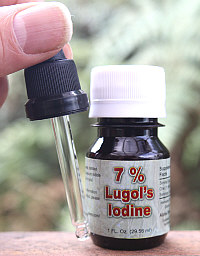
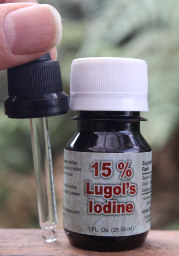
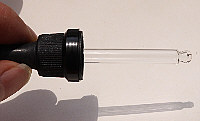
 The 7 and 15% Lugol's solutions now come in
break-resistant pharmaceutical-grade, plastic bottles. The medical-grade dropper (available
separately for $1.25) is optional. In fact, if you have your own clean
dropper, there's no need to purchase another.
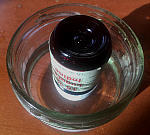 Opening Difficult Top
Opening Difficult Top
& Product Purity
 Our current Lugol's bottles are
designed to survive transoceanic deliveries at high altitude and potential
physical abuse. We take extra precautions with Lugol's because it is a
potent oxidizing agent. Occasionally, a customer will complain
that the top is difficult to open. Simple solution: turn the bottle upside
down. Let sit in a glass or cup of hot water for two minutes, covering
the bottle top but none of the label.
Problem solved.
 The ingredients
in our Lugol's (all variations) are pharmaceutical grade
(BP / USP / EP). A new entry in
this product's
MSDS provides sourcing information.
Email us if you have further questions.
|
 The Thyroid,
The Thyroid,
Iodine & Disease
Prevention
 The role
of the thyroid gland has been understood
for some
time now. Although conventional medicine places emphasis on
its contribution to
regulating the body's
metabolism, an equally important role is its contribution
to the immunological health of the body.
 This organ's thyroid cells
are the only ones in the body capable of absorbing iodine,
an important mineral nutrient and potent germ killer - (though
80% of the less than 25 mg. of iodine in the body is found elswhere,
primarily in muscle and bone, extracellularly - the thyroid has a
concentration of iodine that is
over
1,000 times greater than that found in muscle tissue.)
In terms of immunology, the thyroid gland acts as a gatekeeper:
every 17 minutes all the blood in the body passes through the
thyroid, where this gland's secretion of iodine kills germs
that have come into the body (through absorption of food in the
digestive tract, skin injury, respiratory intake, etc.)
Pathogenic micro-organisms, the primary causative agent for
disease in the body, are made weaker during their passage
through the thyroid gland. With each "17 minute passage"
they are made still weaker until most are killed, provided
the thyroid has its normal supply of iodine.
 We know from clinical study
that few people have anywhere near enough iodine in their
body for the thyroid to function optimally. Three disturbing
trends initiated in the 20th century made this collective
deficiency inevitable: (1) the introduction of chlorine - another
halogen, like iodine - used in drinking water, pools, and as
a ubiquitous cleaning agent in industry, etc. - which
displaces iodine (see far left sidebar), (2) the
alteration of the Western diet to reduce natural food
sources of iodine, and (3) farming practices designed to
increase crop yield which have lead to reduced iodine
content in many foods. Aggravating this diminishing
source issue is the fact that the body does not conserve
iodine the way it does iron. We must receive a regular
dietary or supplemental intake in order to maintain
optimal health.
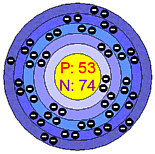
A History
of Lugol's
 Lugol's Iodine Lugol's Iodine (also called
"Lugol's solution") was first developed by the French physician,
Jean Lugol, in 1829. It is a transparent brown liquid consisting
of 10 parts potassium iodide (KI) to 5 parts iodine to 85 parts
of (distilled) water. It is an effective bactericide and
fungicide and, in fact, was, for the better part of a century, a common
antiseptic - (though it has laboratory uses separate and apart
from any medical application). Lugol's and similar iodine solutions probably
fell out of favor in the last half of the 20th century due
to combination of economics and esthetics: first, it is so
cheap to make that it cannot compare to "cleaner," value-added
antiseptics with more marketing muscle; and secondly,
it will stain clothes and will even temporarily
stain skin when used topically to treat a wound.
The internal applications of various iodine solutions have
been published and discussed for well over a century.
|
Treating Candida
Mycoplasia &
The Aftermath
of Antibiotic Usage
 Many alternative physicians
will use Lugol's for these conditions -- just
6 drops, 4 times daily (24 drops per day).
(Read Dr. Orian Truss).
 Precautions:
Lugol's
Precautions:
Lugol's, like
bio-oxidative preparations,
is oxidative. You should avoid taking anti-oxidant
vitamin supplements (particularly Vitamin C and E)
for the duration of your "higher-than-normal"
usage of Lugol's. You should also follow high
usage of iodine products with Microflora
Restoration - or similar products to replenish vital
intestinal flora.
What Formula
Do You Use?
 We are frequently asked what
formula we us in making our Lugol's: 2% or 3% or 5%.
 To make the
original version, we use what amounts to a 3% (2.91%)
formula (iodine and iodine
compound). The formula is simple: 80 gm. of potassium
iodine (KI) is added to 4,000 ml of distilled water (roughly 4,000 gm).
After fully dissolving, 40 gm. of iodine crystal is added.
After the iodine crystal fully dissolves (which takes several
hours), the product is packaged and stored.
 To make the
newer 7% Lugol's version, using the same 4,000 ml.
of distilled water, the amounts of iodine use are
200 gm. of KI, and 100 gm. of iodine crystal.
For 15% Lugol's, to 4,000 ml. of distilled water
we dissolve 480 gm. of KI and 240 gm. of iodine crystal.
 Lugol's Iodine has
an optimal shelf-life of approximately one year. Many web
sites encourage you to "stock up," which does not take into
account this fact. You should purchase just what you need,
and annually rotate out older product.
|